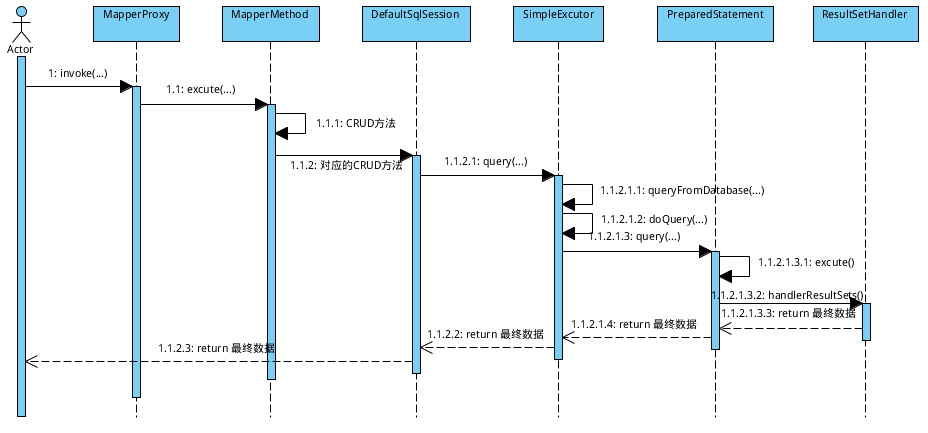Mybatis的所有语句的执行都是通过SqlSession对象来操作的,SqlSession是由SqlSessionFactory类生成的。首先根据配置文件来创建一个SqlSessionFactory,然后调用openSession来获取一个SqlSession。

openSession方法主要是调用openSessionFromDataSource方法返回一个DefaultSqlSession对象:
private SqlSession openSessionFromDataSource(ExecutorType execType, TransactionIsolationLevel level, boolean autoCommit) {
Transaction tx = null;
DefaultSqlSession var8;
try {
Environment environment = this.configuration.getEnvironment();
TransactionFactory transactionFactory = this.getTransactionFactoryFromEnvironment(environment);
tx = transactionFactory.newTransaction(environment.getDataSource(), level, autoCommit);
Executor executor = this.configuration.newExecutor(tx, execType);
var8 = new DefaultSqlSession(this.configuration, executor, autoCommit);
} catch (Exception var12) {
this.closeTransaction(tx);
throw ExceptionFactory.wrapException("Error opening session. Cause: " + var12, var12);
} finally {
ErrorContext.instance().reset();
}
return var8;
}之后根据这个DefaultSqlSession对象来获取MapperProxy对象:

MapperProxyFactory通过动态代理访问Dao层中的mapper接口
public class MapperProxyFactory<T> {
private final Class<T> mapperInterface;
private final Map<Method, MapperMethod> methodCache = new ConcurrentHashMap();
public MapperProxyFactory(Class<T> mapperInterface) {
this.mapperInterface = mapperInterface;
}
public Class<T> getMapperInterface() {
return this.mapperInterface;
}
public Map<Method, MapperMethod> getMethodCache() {
return this.methodCache;
}
protected T newInstance(MapperProxy<T> mapperProxy) {
return Proxy.newProxyInstance(this.mapperInterface.getClassLoader(), new Class[]{this.mapperInterface}, mapperProxy);
}
public T newInstance(SqlSession sqlSession) {
MapperProxy<T> mapperProxy = new MapperProxy(sqlSession, this.mapperInterface, this.methodCache);
return this.newInstance(mapperProxy);
}
}具体的SQL执行还是使用的Excutor:

MapperProxy执行SQL会触发invoke方法,最后使用execute来执行CRUD:
public Object invoke(Object proxy, Method method, Object[] args) throws Throwable {
try {
//代理以后,所有Mapper的方法调用时,都会调用这个invoke方法
//并不是任何一个方法都需要执行调用代理对象进行执行,如果这个方法是Object中通用的方法(toString、hashCode等)无需执行
if (Object.class.equals(method.getDeclaringClass())) {
return method.invoke(this, args);
}
if (this.isDefaultMethod(method)) {
return this.invokeDefaultMethod(proxy, method, args);
}
} catch (Throwable var5) {
throw ExceptionUtil.unwrapThrowable(var5);
}
//去缓存中找MapperMethod
MapperMethod mapperMethod = this.cachedMapperMethod(method);
//执行
return mapperMethod.execute(this.sqlSession, args);
}execute内部调用SqlSession的CRUD方法,比如selectList方法:
public <E> List<E> selectList(String statement, Object parameter, RowBounds rowBounds) {
try {
MappedStatement ms = configuration.getMappedStatement(statement);
//CRUD实际上是交给Excetor去处理, excutor其实也只是穿了个马甲而已,小样,别以为穿个马甲我就不认识你嘞!
return executor.query(ms, wrapCollection(parameter), rowBounds, Executor.NO_RESULT_HANDLER);
} catch (Exception e) {
throw ExceptionFactory.wrapException("Error querying database. Cause: " + e, e);
} finally {
ErrorContext.instance().reset();
}
}然后,通过一层一层的调用,最终会来到doQuery方法, 这儿咱们就随便找个Excutor看看doQuery方法的实现吧,我这儿选择了SimpleExecutor:
public <E> List<E> doQuery(MappedStatement ms, Object parameter, RowBounds rowBounds, ResultHandler resultHandler, BoundSql boundSql) throws SQLException {
Statement stmt = null;
try {
Configuration configuration = ms.getConfiguration();
StatementHandler handler = configuration.newStatementHandler(wrapper, ms, parameter, rowBounds, resultHandler, boundSql);
stmt = prepareStatement(handler, ms.getStatementLog());
//StatementHandler封装了Statement, 让 StatementHandler 去处理
return handler.<E>query(stmt, resultHandler);
} finally {
closeStatement(stmt);
}
}接下来,咱们看看StatementHandler 的一个实现类 PreparedStatementHandler(这也是我们最常用的,封装的是PreparedStatement), 看看它使怎么去处理的:
public <E> List<E> query(Statement statement, ResultHandler resultHandler) throws SQLException {
PreparedStatement ps = (PreparedStatement) statement;
ps.execute();
//结果交给了ResultSetHandler 去处理
return resultSetHandler.<E> handleResultSets(ps);
}参考文章:

